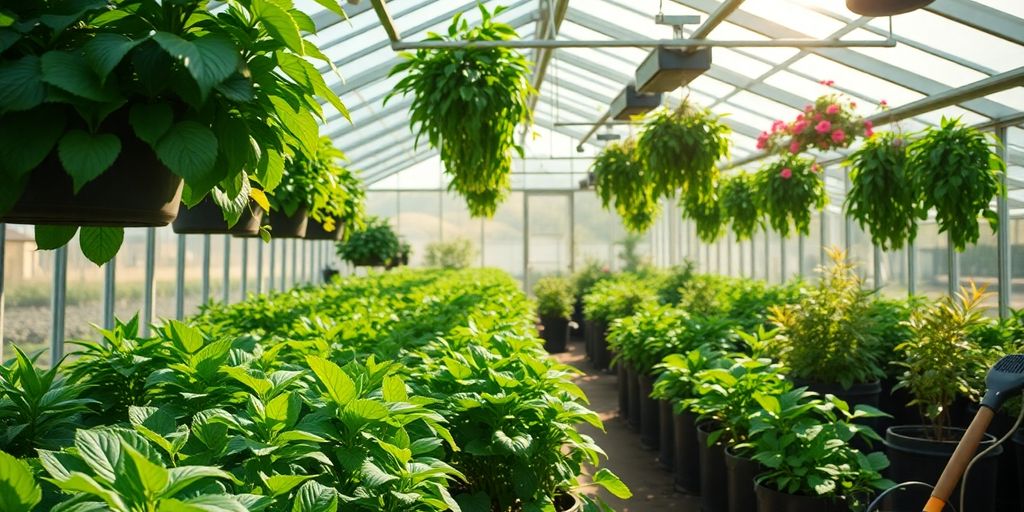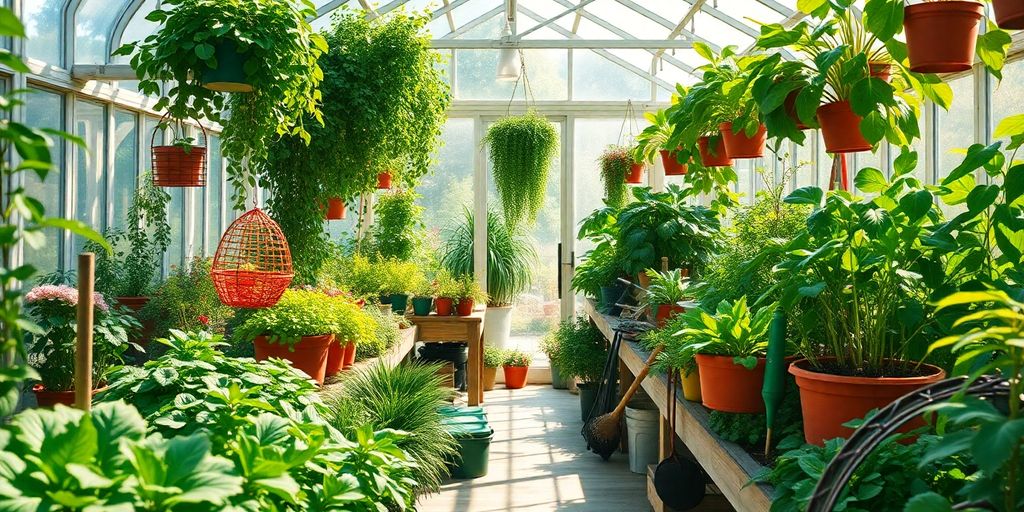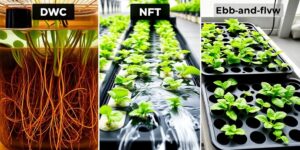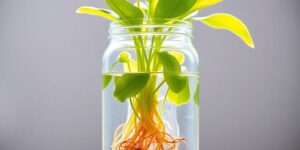Thinking about building a greenhouse? It’s a great way to grow plants year-round, no matter the weather. But it can feel like a lot to figure out, especially when it comes to design and how much it’ll all cost. This guide is here to help break it all down for you. We’ll cover everything from what you need to consider before you start, to picking the right structure, and even how to keep your plants happy and healthy inside. Our goal is to make this Greenhouse design and cost guide super clear so you can build the greenhouse of your dreams without too much stress.
Key Takeaways
- Figure out what you want to grow and how you’ll use your greenhouse before you start planning. This helps decide the size and features you’ll need.
- Greenhouse kits are a good option if you want something easy to put together. Glass greenhouses look nice and last a long time, but they cost more.
- Think about the materials for your frame and panels. Strong frames and good panels are important for keeping your greenhouse in good shape.
- Good airflow and temperature control are super important for healthy plants. You’ll need to think about vents, fans, and maybe heaters or coolers.
- Keeping plants fed and pest-free is key. There are simple ways to handle pests and fertilize your plants without using harsh chemicals.
Understanding Your Greenhouse Needs
Before you even start looking at structures or materials, it’s really important to figure out what you actually want from a greenhouse. It’s not just about having a fancy garden building; it’s about creating a space that works for you and the plants you want to grow. Thinking this through now will save you a lot of headaches and money down the road.
Defining Your Growing Goals
So, what exactly do you plan on doing in your greenhouse? Are you hoping to start seeds super early in the spring, maybe grow some tomatoes and peppers through the summer, or perhaps keep delicate plants alive through a harsh winter? Be realistic about what you want to achieve. For instance, if you live somewhere with really cold winters, trying to grow heat-loving crops year-round might mean a huge heating bill. It’s better to set achievable goals based on your climate and what you’re willing to invest in terms of time and money.
Assessing Your Climate and Location
Your local weather plays a big part in how you’ll use your greenhouse. Think about how much sun you get, especially during the winter months. A spot that gets at least six to eight hours of direct sunlight daily is ideal, particularly if you want to extend the growing season. Also, consider wind exposure. A very windy spot might require a sturdier structure or windbreaks. You’ll also want to think about access to water and electricity. Running a hose or setting up an electrical outlet nearby can make a big difference in how easy it is to manage your greenhouse.
Determining Your Budget
Greenhouses can range from simple, inexpensive hoop houses to elaborate glass structures. You need to decide how much you’re comfortable spending. Your budget will influence the size, materials, and features you can afford. Remember to factor in not just the initial cost of the greenhouse itself, but also any ongoing costs like heating, cooling, or electricity for fans and lights. It’s wise to have a clear budget in mind before you start shopping around.
Choosing the Right Greenhouse Structure
When you’re setting out to build your own greenhouse, one of the first big decisions you’ll face is the structure itself. It’s not just about looks; the frame and covering play a huge role in how well your greenhouse performs and how long it lasts. Think about what you want to grow and for how long – this will really guide you toward the best option.
Exploring Greenhouse Kit Options
Greenhouse kits are a super popular choice because they take a lot of the guesswork out of building. They come with all the parts you need, usually with instructions that make assembly pretty straightforward. This means you can get up and running without needing to be a master builder. They’re great if you want a quicker setup or if you’re new to this kind of project. You can find kits made from different materials, like polycarbonate panels or glass, and they come in all sorts of sizes, from small ones for a patio to larger walk-in models. It’s a good way to get a functional greenhouse without the hassle of sourcing every single piece yourself. Many gardeners find that a well-chosen kit offers a good balance of cost and quality for their gardening needs.
The Advantages of Glass Greenhouses
Glass greenhouses are often seen as the premium option, and for good reason. They offer fantastic light transmission, letting in almost all the natural sunlight your plants could want. Plus, glass panels tend to stay clear and don’t degrade over time like some other materials might. They also have a classic, attractive look that can really add to your property. While they can be more expensive upfront and might require a bit more care due to the glass, their longevity and aesthetic appeal make them a worthwhile investment for many serious gardeners. They also tend to insulate better, which can save on heating costs in cooler months.
DIY Greenhouse Frame Materials
If you’re leaning towards a DIY approach for your greenhouse frame, you’ve got a few material choices to consider. Aluminum is a popular pick because it’s lightweight, won’t rust, and is quite strong. Galvanized steel is another solid option; it’s very sturdy and can handle heavier loads, though you’ll want to make sure it’s properly treated to prevent rust over many years. Wood frames offer a traditional look and are easy to work with, but they do require regular maintenance, like sealing and painting, to protect them from the elements and prevent rot. The frame material you choose will directly impact the durability and stability of your entire structure, so it’s worth putting some thought into it.
Essential Greenhouse Components and Materials

Selecting Durable Panel Types
When you’re picking out the panels for your greenhouse, think about what you’re growing and how much light they’ll need. Glass is classic, offering great light transmission, but it can be heavy and breakable. Polycarbonate panels are a popular choice because they’re tough, shatterproof, and offer good insulation. They diffuse light nicely, which can be great for plants that don’t like direct, harsh sun. Some polycarbonate panels even have UV protection built-in, which is a big plus for keeping things from getting too hot or damaged.
Prioritizing Frame Strength and Material
The frame is what holds everything together, so you want it to be sturdy. Aluminum frames are lightweight and won’t rust, which is pretty convenient. Steel frames are strong, but you’ll want to make sure they’re galvanized or treated to prevent rust, especially if you live somewhere damp. Wood frames look nice, but they need regular upkeep to stop rot and pests. For serious growers, looking at manufacturers like MIILKIIAGROW can be a good idea, as they focus on long-lasting construction MIILKIIAGROW.
Incorporating Ventilation and Airflow
Good airflow is super important for keeping plants healthy and preventing diseases. You need a way to get fresh air in and stale air out. Roof vents are great because hot air rises, so they let it escape naturally. Roll-up sides or louvred vents on the walls also help create a cross-breeze. If you plan on using fans, make sure you have power access sorted out. Proper ventilation helps control temperature and humidity, which are key to a happy greenhouse environment.
Optimizing Your Greenhouse Environment

Getting your greenhouse environment just right is key to happy plants. It’s not just about putting them in a box and hoping for the best. You’ve got to think about temperature, humidity, and how the air moves around.
Effective Temperature Regulation Strategies
Temperature is probably the first thing people think of. You want it warm enough for your plants, but not so hot they bake. Using materials that absorb and retain heat can make a big difference, especially during cooler months. Think about adding black gravel to the floor or placing black rain barrels filled with water inside. These absorb sunlight during the day and release that warmth slowly at night. For more active control, especially if you’re trying to keep things going early in spring or late in fall, you might need a small heater. Just be sure you have power access sorted out for that. On the flip side, on really hot days, you need a way for that heat to escape. Opening vents or doors is the simplest way, but automated vent openers can be a lifesaver if you can’t be there to do it yourself.
Maintaining Optimal Soil Health
Healthy soil is the foundation for healthy plants. It’s not just about the dirt you put in; it’s about keeping it alive and full of nutrients. Regular soil testing can tell you what’s missing. You can amend your soil with compost or other organic matter to keep it rich. Avoid over-compacting the soil by not walking on it too much, especially when it’s wet. If you’re using containers or raised beds, make sure your potting mix drains well. Good drainage prevents root rot, which is a common problem.
Watering Techniques for Greenhouse Plants
Watering can be a bit tricky in a greenhouse. Plants are often closer together, and the environment can dry out faster than outside. Consistency is more important than the amount of water. It’s better to water thoroughly less often than to give them a little bit every day. Check the soil moisture by sticking your finger in a few inches deep. If it feels dry, it’s time to water. Drip irrigation or soaker hoses are great for delivering water directly to the roots, which also helps keep the foliage dry and reduces the chance of disease. If you’re using automated systems, you can set them to water based on soil moisture sensors, which takes a lot of the guesswork out of it. Having easy access to water, whether through a hose or a more permanent setup, makes this task much simpler. You can find some great tips on setting up irrigation systems at Planta Greenhouses Canada.
Keeping your greenhouse environment balanced means paying attention to all these factors. It’s a bit like managing a tiny ecosystem, and when you get it right, your plants will really show it.
Managing Pests and Plant Nutrition
Keeping your greenhouse plants healthy means dealing with the little critters and making sure they get the right food. It sounds simple, but honestly, it’s a constant balancing act. You’ve got to be ready because pests and diseases can pop up fast, especially when your greenhouse is providing such a great environment for your plants. It’s like they’re invited to the party too!
Eco-Conscious Pest Control Methods
When you see bugs, the first thought might be to grab the strongest spray you can find. But that’s usually not the best move for a greenhouse. Instead, think about prevention and using gentler methods first. Things like making sure your greenhouse is sealed up tight with fine mesh on vents can stop many pests from even getting in. If they do get in, a strong blast of water can knock off aphids and spider mites. For tougher situations, beneficial insects are a game-changer. Ladybugs eat aphids, and predatory mites can handle spider mites. You can also use sticky traps to catch flying pests like whiteflies and thrips. It’s all about catching problems early before they get out of hand. Learning about best practices for managing pesticide resistance is also super important so you don’t make things worse.
Safe Fertilization Practices
Plants need food, just like we do, but you have to give it to them correctly. Over-fertilizing can actually hurt your plants, making them weak and more prone to disease. It’s better to feed them regularly with smaller amounts. Organic fertilizers are a good choice because they release nutrients slowly. Compost tea is another great option that adds beneficial microbes to your soil. Always follow the instructions on the fertilizer package, and when in doubt, it’s better to under-fertilize than over-fertilize. Your plants will thank you by staying strong and healthy.
Protecting Plants from Pests and Diseases
So, how do you keep everything from going wrong? It really comes down to being observant and acting fast. Regularly check your plants, especially the undersides of leaves, for any signs of trouble. Early detection is key. If you spot a few aphids, blast them off with water. See a bit of powdery mildew? Improve airflow and prune affected leaves. For more serious issues, like bacterial wilt spread by beetles, you might need to use row covers or specific treatments. The goal is to create a healthy environment where plants can thrive, and pests and diseases have a harder time taking hold. It’s a bit like being a detective for your plants – always looking for clues and knowing what to do when you find them.
Maximizing Your Greenhouse Investment
So, you’ve got your greenhouse set up, and it’s looking pretty good. But how do you make sure you’re really getting the most out of it, year after year? It’s not just about having a structure; it’s about making it work for you, extending what you can grow and when. Think of it as a long-term project where each season teaches you something new.
Extending Your Growing Season
This is probably the biggest perk of having a greenhouse. You can start seeds way earlier in the spring than you ever could outside. Frost? No problem. Cold snaps? Your plants are cozy inside. And in the fall, you can keep harvesting long after the first frost hits the ground. It’s like having your own personal summer that lasts for months longer.
Efficient Space Utilization Techniques
Greenhouses can sometimes feel a bit limited in space, right? But there are smart ways to pack more in. Think vertical! Shelving units, hanging baskets, and tiered planters can really make a difference. You can also use rolling benches, which let you move plants around and access different areas easily. It’s all about thinking up, not just out.
Enhancing Property Value with a Greenhouse
Beyond just growing your own food, a well-designed and maintained greenhouse can actually add value to your home. It shows potential buyers that the property is well-cared for and offers a unique lifestyle benefit. It’s a feature that can really make your place stand out from the crowd. Plus, who wouldn’t want a beautiful, functional greenhouse on their property?
Making smart choices about your greenhouse setup from the start can save you a lot of headaches and money down the line. It’s about planning for efficiency and longevity, so your investment keeps paying off.
Your Greenhouse Journey Starts Now
So, you’ve got the rundown on building your own greenhouse, from picking the right materials to figuring out the costs. Whether you’re leaning towards a DIY build or a ready-made kit, the key is to match it to what you want to grow and how you want to use it. Remember, it’s not just about the structure; it’s about creating a space where your plants can really thrive, no matter the season. Don’t get too caught up in perfection from the start. Your greenhouse will evolve, and you’ll learn with every season. Start small, get your hands dirty, and enjoy the process of growing your own food and flowers year-round. Happy gardening!
Frequently Asked Questions
How do I decide what kind of greenhouse I need?
Think about what you want to grow, like vegetables or flowers, and how much space you need. Also, consider how many months a year you want to use it and what temperatures you want inside. This helps you pick the right size and features.
What’s the difference between a greenhouse kit and building one myself?
Greenhouse kits are great because they come with all the parts and instructions, making them easy to put together. You can also build one yourself using materials like wood or metal, which might save money but takes more effort.
What are the pros and cons of glass versus plastic greenhouse panels?
Glass greenhouses let in the most sunlight and look really nice, lasting a long time. However, they can be more expensive. Polycarbonate panels are tough, don’t break easily, and offer good protection, making them a popular choice too.
Why is ventilation so important in a greenhouse?
Good airflow is super important! You can use vents, fans, or even open doors and windows to keep the air moving. This helps control the temperature and humidity, which keeps plants healthy and stops diseases from spreading.
How can I keep my plants healthy and pest-free?
To keep plants healthy, make sure the soil is good by adding compost or other organic matter. Water them just right – not too much, not too little. Also, watch out for pests and use safe ways to get rid of them, like natural sprays or beneficial insects.
How does a greenhouse help me grow plants for longer?
You can extend your growing season by using a greenhouse to protect plants from cold weather, frost, and pests. This means you can start seeds earlier in the spring and keep growing later into the fall, or even all year round!





